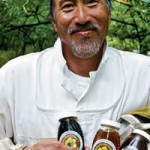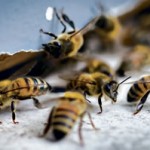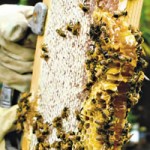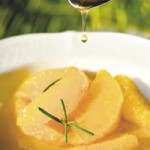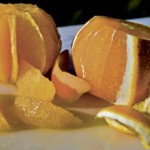Strong Bees, Healthy Hives
Chris Kauwe sells raw honey gathered from five bee yards and 60 hives in Maha’ulepu, Kalaheo, Waimea and Koloa.
“You’re tasting the flowers of Koloa,” Kauwe tells me at his Koloa bee yard. “You’re tasting cactus, kiawe, coconut any of the plants within about a mile radius of this area.”
Kauwe has been a beekeeper for 10 years and hasn’t noticed a reduction in his population. The beekeeping industry typically uses docile “domesticated” bees to avoid getting stung, but Kauwe’s bees are crafted by Mother Nature, and their naturally aggressive character is strong enough to fight off common pests and diseases. For this reason, Kauwe doesn’t use pesticides or chemicals to maintain his hives.
What’s available now: Light, medium and dark honey.
HONEY
Globally, honey is steeped in lore and has been used for health, food and in rituals for thousands of years. In China, the art of beekeeping is ancient beyond memory or record, and in Valencia, Spain, a 10,000 year-old cave painting shows two females collecting honey from a wild beehive. It is one of the five elixirs for Hindu immortality, and ancient Egyptians offered it to their fertility god, Min. Honey is a symbol of Rosh Hashanah, the Jewish new year, and the Christian New Testament says John the Baptist survived on locusts and wild honey.
Season: Bees use the flowers’ nectar to make their food, and store both the honey and pollen in honeycombs. When there are fewer flowers, the bee population begins to die down. Flowers start to blossom in April on Kaua’i, and continue to bloom through December.
Storage: Pure honey keeps best in an airtight container in a dry place at room temperature. An airtight cover is necessary because honey loses aroma and flavor and absorbs moisture and odors when exposed to air.
Tip: Honey may crystallize or granulate as it gets older or if it is refrigerated or frozen. This is a natural process and doesn’t harm the honey. To return crystallized honey to liquid form, place the open container of honey in a pan of hot (not boiling) water until crystals disappear.
Preparation: Honey can be used on toast, biscuits and scones; drizzled over yogurt; added to mustard for a dip, or used in salad dressings and syrups. A 50-50 ratio of honey heated in water makes a sweetener that can be used in cocktails, tea and sorbets, or poured over cakes for flavor and moisture. Popular honey infusions include citrus, ginger, herbs and flowers.
Honey is excellent drizzled over cheeses such as blue, ricotta, Parmesan, feta, goat or aged Cheddar. Fruits and nuts pair well with this classic sweet and savory preparation.
Health benefits: According to the Nutrition Almanac, “Honey is one of nature’s finest energygiving foods, consisting of carbohydrates in the most easily digestible form. It has strong antibiotic, sleep-inducing and tranquilizing properties.”
Honey is used topically for its antiseptic and antibacterial properties that aid in the healing of wounds from burns, rashes and diabetic ulcers.
To build your immunity and relieve a scratchy throat or cough, take a spoonful of an infusion made with eight raw cloves of garlic and one cup of honey simmered over low heat for three minutes.
Honi Honi Honey can be found at: Retail: Kukuiula Market, Living Foods Market & Cafe, Koa Kea Hotel and Resort, The Wine Shop; Farmers Markets: Kukui Grove (Mondays at 3 p.m.), Kaua’i Community College (Saturday at 9:30 a.m.) Call 652-8897, or email honihonihoney@hotmail.com.
- Beekeeper Chris Kauwe. Daniel Lane photos
- Naturally aggressive bees protect the hive from disease
- There are approximately 15,000 bees and one queen per hive
- Honeycombs store honey, pollen and larvae
- ‘Honi’ means kiss in Hawaiian
- Sweet Honi Oranges. Daniel Lane photos
- Segment orange by slicing between flesh and membrane

